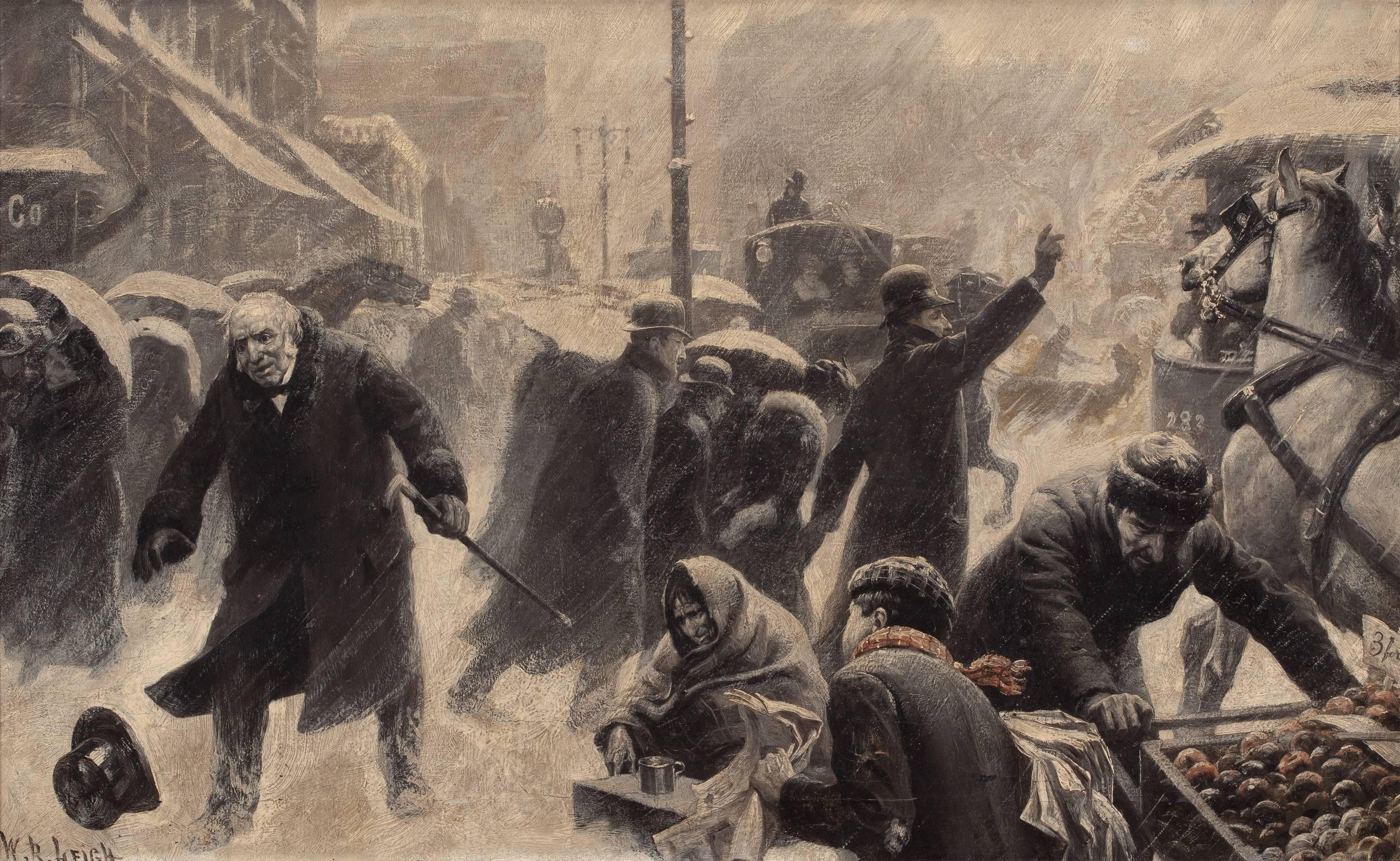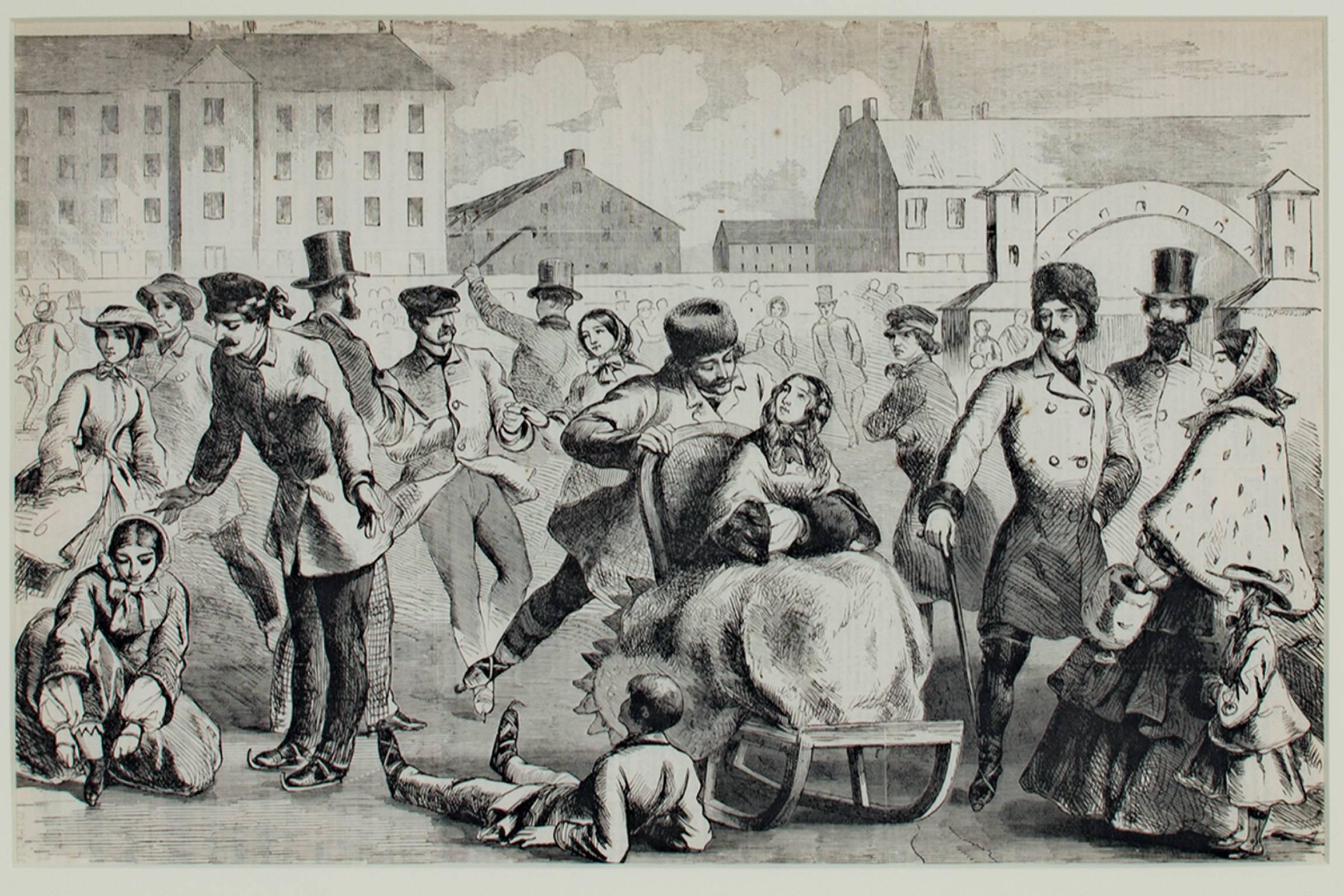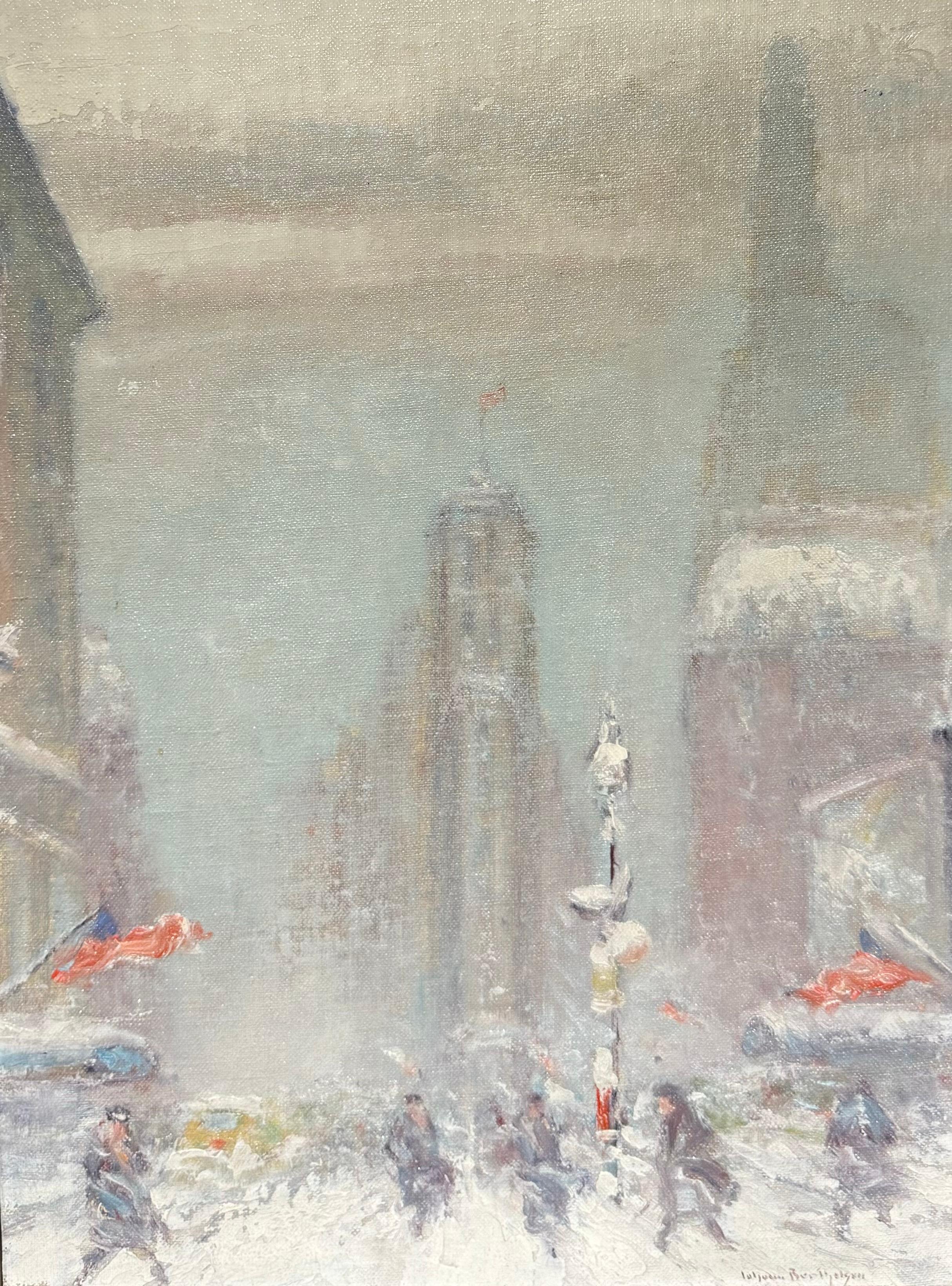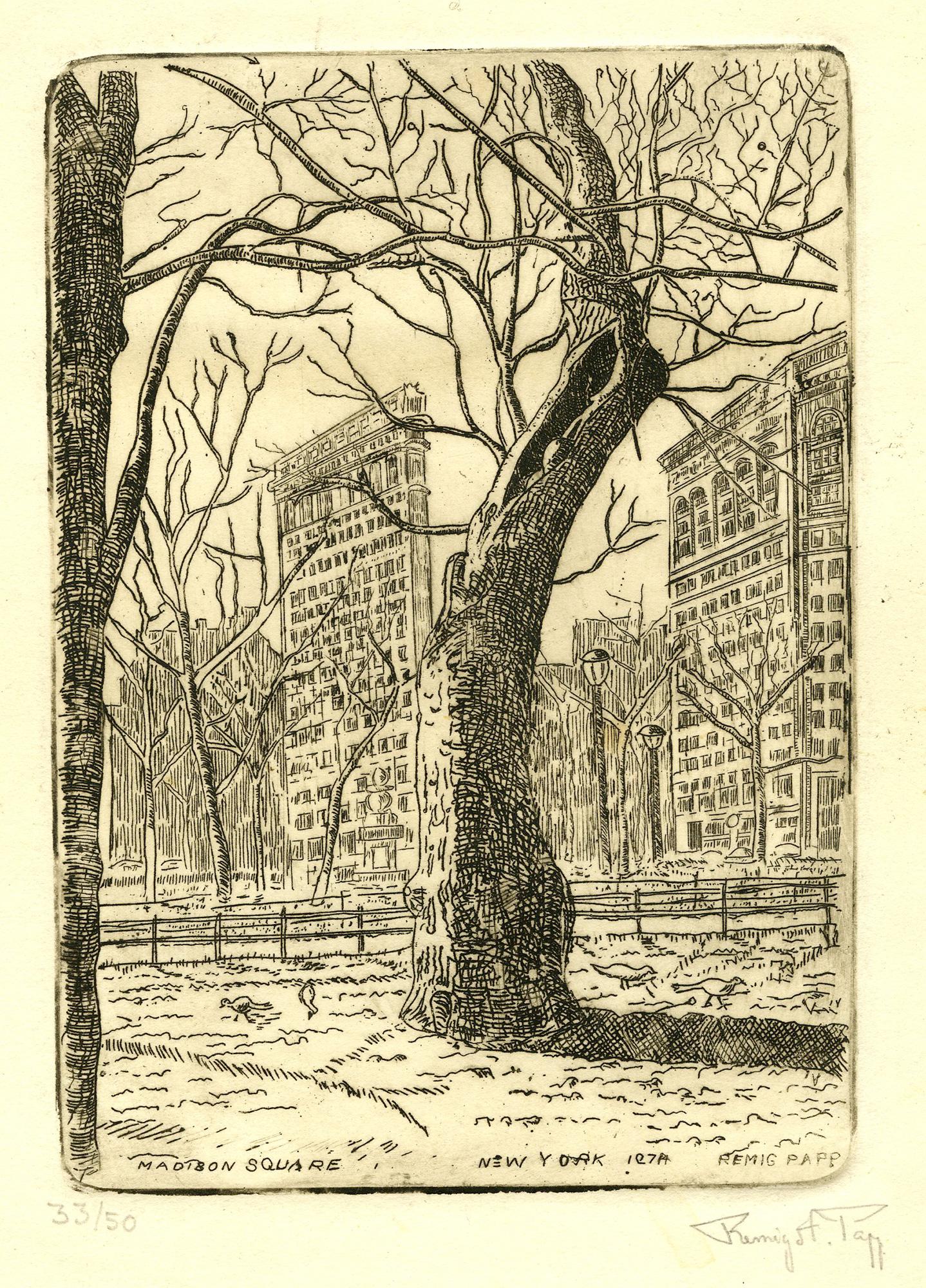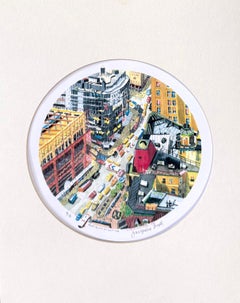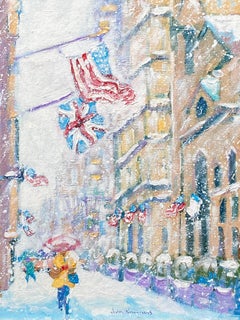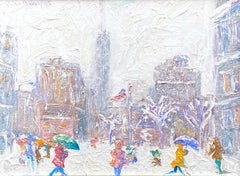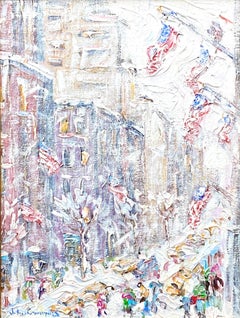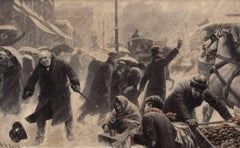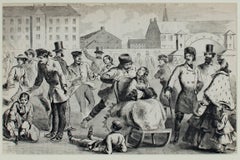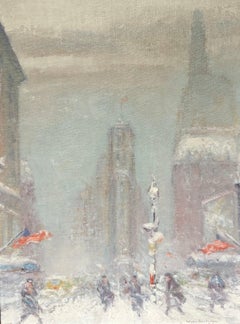Items Similar to “Scene in Union Square, New York on a March Day
Want more images or videos?
Request additional images or videos from the seller
1 of 7
“Scene in Union Square, New York on a March Day1860
1860
$228
$28520% Off
£176.74
£220.9320% Off
€200.06
€250.0820% Off
CA$326.32
CA$407.9020% Off
A$356.08
A$445.1120% Off
CHF 184.83
CHF 231.0420% Off
MX$4,260.24
MX$5,325.3020% Off
NOK 2,346.07
NOK 2,932.5820% Off
SEK 2,197.53
SEK 2,746.9120% Off
DKK 1,494.38
DKK 1,867.9820% Off
About the Item
Original wood engraving on paper. Taken from Harper’s Weekly, April 7, 1860. Signed “Homer” in the plate. Condition is good. Slight staining lower left. Very slight tear to the left of the 3rd line starting with the word “Policeman”. Framed in a simple thin black frame with gold inner liner. Frame has wear consistent with age. Under glass. Overall framed size is good 12.75 by 14.25 inches. Provenance: A Sarasota, Florida estate.
Winslow Homer was born in Boston, Massachusetts, in 1836, the second of the three children, all sons, of Henrietta Benson and Charles Savage Homer. His artistic education consisted chiefly of his apprenticeship to the Boston commercial lithographer John H. Bufford, and a few lessons in painting from Frédéric Rondel after that. Following his apprenticeship, Homer worked as a free-lance illustrator for such magazines as Harper's Weekly.
In 1859 he moved to New York City, where began his career as a painter. He visited the front during the Civil War and his first important paintings were of Civil War subjects. In 1867 he spent a year in France. At Gloucester, Massachusetts, in 1873 he began to paint in watercolor. In 1875 he submitted his last drawing to Harper's Weekly, ending his career as an illustrator. He traveled widely in the 1870s in New York State, to Virginia, and Massachusetts, and in 1881 he began a two-year stay in England, living in Cullercoats, near Newcastle.
Returning to America in 1883, he settled at Prout's Neck, Maine, where he would live for the rest of his life. He continued to travel widely, to the Adirondacks, Canada, Bermuda, Florida, and the Caribbean, in all those places painting the watercolors upon which much of his later fame would be based. In 1890 he painted the first of the series of seascapes at Prout's Neck that were the most admired of his late paintings in oil. Homer died in his Prout's Neck studio on September 30, 1910.
- Creation Year:1860
- Dimensions:Height: 5.25 in (13.34 cm)Width: 7.5 in (19.05 cm)Depth: 0.75 in (1.91 cm)
- Medium:
- Movement & Style:
- After:Winslow Homer (1836 - 1910, American)
- Period:
- Condition:Slight staining lower left with normal toning of paper. Very tiny tear to the left of the word policeman in line 3 on bottom of the engraving.
- Gallery Location:Southampton, NY
- Reference Number:1stDibs: LU14113951912
About the Seller
5.0
Platinum Seller
Premium sellers with a 4.7+ rating and 24-hour response times
Established in 1977
1stDibs seller since 2013
550 sales on 1stDibs
Typical response time: <1 hour
- ShippingRetrieving quote...Shipping from: Southampton, NY
- Return Policy
More From This Seller
View All“Herald Square at Lunch Time”
Located in Southampton, NY
Original screen print which would be considered a silkscreen or serigraph of a birds eye view of Herald Square in New York City at lunch time by the contemporary American artist, Jacqueline Fogel. Edition 3/15. Signed in lower right margin by the artist. Executed in 1988. Condition is excellent. Currently unframed. Professionally matted. Overall matted measurements are 14 by 11 inches. Framing options are available. Provenance: A Venice, Florida collector.
This park was named for the newspaper that was once published directly to its north. The City of New York acquired the area in 1846 as part of the opening of Bloomingdale Road (now Broadway). By the early 20th century, many printers and publishers had located in the area. The New York Herald, founded by James Gordon Bennett in 1835, was best known for its sensational coverage of scandal and crime, and for its enormous circulation. Herald Square's centerpiece monument to Bennett and his son houses a sculpture and clock that formerly topped the Herald building. The bronze figures include Minerva, the goddess of wisdom and invention, and two bell-ringing blacksmiths. The clock and figures were installed on the monument in 1940, and blacksmiths "Stuff and Guff" or "Gog and Magog" have chimed the hours
Born Oct. 13, 1928, in Brooklyn, as a child she showed a great interest in drawing. She attended the Philadelphia School of Art and maintained a career as an artist throughout her life. Impressed by the native American art represented in Kachina dolls, she developed a personal style in her 20s that always incorporated bright colors. Her work ranged from land and cityscape watercolors to small to life-size polychrome sculptures made almost entirely from discarded ornate furniture parts and other found or collected objects. In 2000, she was given the opportunity to create cow sculptures for the New York Cow Parade, and in 2002 she painted sculptures for the Rescue Dog book honoring the working dogs from Sept. 11, 2001. In 2005, her Big Apple sculpture was displayed outside Trump Tower. She swam regularly in Jamaica Bay and maintained an active and vibrant lifestyle throughout her life, attending many parties, art exhibits and concerts. Fogel's multifaceted planes which should recede far into the distance and give the illusion of depth because of their tonality and color intensity appear, instead, to be on the same plane. Because the depth of field is flattened, the color areas become rather decorative. In addition, the planes on the buildings are charmingly tilted and destorted, contributing to the zaniness and gaiety of these paintings. Fogel has a graceful sense of composition and her placement of shapes is always sound. The paintings, while they seem so effortless and unselfconscious, belie an unobtrusive and playful artistic intelligence. Fogel enjoys dealing with visual paradoxes in a natural, unforced and unselfconscious manner. Shop her watercolor art for sale online. SELECTED EXHIBITIONS 2002DOGNY 2000Cowparade, NY 1998Michael Ingbar Gallery, NY 1996-2002Nassau County Museum, Roslyn, NY 1993-2002Guild Hall, East hampton, NY 1991Housatonic Museum of Art, Bridgeport, CT 1990, 1997Elaine Benson Gallery, Bridgehampton, NY 1987, 1988Bergen County Museum, New Jersey 1986-1989The Country Gallery, long Island, NY 1983Zim Lerner Gallery, NY '83, '85, '86Grace Building, NY 1983Queens Museum, NY 1979, 1980Fabian Gallery, NY 1979Sculpture CEnter, NY 1979Cork Gallery, Lincoln Center, NY '79, '82, '83, '87, '90, '93, '94, '96Lever House, NY 1968, 1972, 1979Gold Door Gallery, Bucks County, Pa. 1968Brooklyn Museum, NY 1966Madison Square Garden Art and Antique Show, NY 1962New Jersey Water Color Society, New Jersey 1961Newark Museum, New Jersey ONE PERSON SHOWS 1997, 1999Temple Emanuel Gallery, Great Neck, New York 1996Shelter Rock Gallery, Long Island, New York 1989East End Arts, Long Island, New York 1985The Manhattan Borough President's Gallery, New York 1984The Erato Gallery, St. Maarten, Caribbean, NY 1982, 1985Mari Gallery, Mamaroneck, NY 1981Perin - Sharpe Gallery, New Caanan, CT 1981Hooks-Epstein Gallery, Houston, TX 1974Aberbach Fine Art, NY 1971Kutztown Art College, PA 1965, 1966Krasner Gallery, NY 1963Art Alliance, Philladelphia, PA 1960Carus Gallery, NY 1960San Miguel Allende, Mexico COLLECTIONS...
Category
1980s Contemporary Landscape Prints
Materials
Screen
$295 Sale Price
21% Off
“Saks Fifth Avenue”
By John Crimmins
Located in Southampton, NY
Acrylic on artist board painting of the iconic Saks Fifth Avenue building in New York City. Saks Fifth Avenue has been in New York City since 1924. The painting was done in 2020 an...
Category
2010s Post-Impressionist Figurative Paintings
Materials
Acrylic, Board
“Wintry Day, Madison Square”
By John Crimmins
Located in Southampton, NY
Recently completed painting of Madison Square in New York City on a snowy winters day. Signed top left and signed and titled verso. Condition is excelle...
Category
2010s Post-Impressionist Figurative Paintings
Materials
Acrylic, Board
“Flags on Fifth Avenue”
By John Crimmins
Located in Southampton, NY
Original recent acrylic on artist board painting of American flags flying on Fifth Avenue in New York City by the well known Hampton’s artist John Crimmins. Signed by the artist lowe...
Category
2010s Post-Impressionist Figurative Paintings
Materials
Acrylic, Board
“Paris, Place du Tertre”
Located in Southampton, NY
Original hand colored lithograph by the French artist, Maurice Jacque of the Place du Tertre in Montmartre Paris, France. Signed in lower right margin. Titled in lower left margin. ...
Category
Early 1900s Academic Landscape Prints
Materials
Archival Paper, Lithograph
$360 Sale Price
20% Off
“City Snow”
Located in Southampton, NY
Original watercolor and gouache city snowscape attributed to the hand of Hans Peter Nelson. Signed lower left ”H. Nelson”. Condition is excellent. Circa 1940. Under glass. The art...
Category
1940s Ashcan School Landscape Drawings and Watercolors
Materials
Watercolor, Gouache, Archival Paper
$396 Sale Price
20% Off
You May Also Like
New York Street Scene, Collier's Weekly Magazine Story
By William Robinson Leigh
Located in Fort Washington, PA
Date: 1898
Medium: Oil on Canvas
Dimensions: 21.00" x 34.00"
Signature: Signed Lower Left
Exhibited: The Triumph of Winter, National Arts Club, New York, December 16, 2013- January ...
Category
1890s Figurative Paintings
Materials
Canvas, Oil
19th century woodcut print figurative Victorian American urban city scene
By Winslow Homer
Located in Milwaukee, WI
"Skating at Boston" is an original woodcut print by Winslow Homer. It depicts a large number of figures figure skating with Boston in the background.
9...
Category
1850s Realist Figurative Prints
Materials
Woodcut
Coin de Rue Dans Soho
By Jean-Emile Laboureur
Located in New York, NY
Jean-Emile Laboureur (1877-1947), Coin de Rue Dans Soho, woodcut, 1909, signed in pencil lower left and numbered (15/15) [also initials in the plate]. Reference: Sylvain Laboureur 64...
Category
Early 1900s Modern Landscape Prints
Materials
Woodcut
American Impressionist NYC FLATIRON Union Square BROADWAY Painting
By Johann Berthelsen, 1883-1972
Located in New York, NY
Johann Berthelsen (1883 - 1972)
Flatiron, Union Square, Broadway
New York City
Oil on Board
15 x 11inches
19 X 15 inches with frame
Signed lower right: Johann Berthelsen;
Original frame
Painting is very good original condition
Notice All the Beautiful Flags in the Painting!
Berthelsen painted landscapes of New York City ''poetic'' by contemporary critics. Ironically though, it was music not art, to which Berthelsen originally aspired to. A native of Copenhagen, Denmark, Berthelsen's family immigrated to the United States in 1890. When he was 18, Berthelsen studied music and voice for four years at the Chicago Musical...
Category
1960s American Impressionist Paintings
Materials
Oil
Madison Square, N.Y.C.
Located in Middletown, NY
New York: 1947.
Etching on white wove paper, 7 x 5 inches (752 x125 mm), full margins. Signed and titled in pencil, lower margin. In very good condition with some minor spots of ligh...
Category
Mid-20th Century American Modern Landscape Prints
Materials
Etching
"Union Square" NYC American Scene Social Realism Modernism WPA Mid-20th Century
By Agnes Hart
Located in New York, NY
"Union Square" NYC American Scene Social Realism Modernism WPA Mid-20th Century
Agnes Hart (American, 1912-1979)
"Union Square, New York City"
Sight: 14 1/2 x 21 1/2 inches
Gouache...
Category
1940s American Modern Landscape Paintings
Materials
Gouache, Board
More Ways To Browse
Antique Framing Square
Peter Doig Signed Prints
Peter Max 1981
Peter Max Rainbow
Pettibon Poster
Picasso Lithograph Ballet
Picasso Lithographs 1964
Picasso Numbered Print
Picasso Plage
Picasso Tree
Pierre Brissaud
Portrait Self Collage
Raoul Dufy Signed Prints
Richard Ellis
Roy Lichtenstein Signed Poster
Salvador Dali Flordali
Secession Poster
Sidney Chafetz
